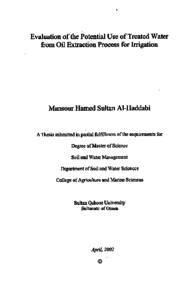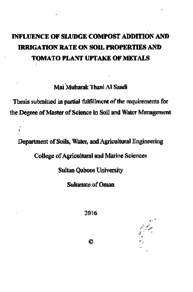Document
Evaluation of the potential use of treated water from oil extraction process for irrigation.
Publisher
Sultan Qaboos University
Gregorian
2002
Language
English
Subject
English abstract
Large quantities of water are produced during oil extraction in Oman, which form the largest single waste in the entire oil producing business. This water is utilized for reservoir pressure maintenance by injection into shallow and deep sub surface formations at oil fields. According to Oman environmental regulations, this practice has to stop very soon. The water is saline and heavily contaminated with oil. It is, therefore, desirable to find a method that utilizes the large quantity of oil contaminated water after treatment. The overall objective of this study was to assess the suitability of using treated water for irrigation. Investigation on the effect of using treated water on soil physical properties was also conducted. Other objectives were to investigate the effect of treated water on heavy metals accumulation in soil and to determine if there is any relationship between salinity, pH, and sodicity with time, depth of soil, water application rates, and type of water and their interactions. A pilot scale study was conducted at Sultan Qaboss University to treat the produced water continuously using a combined air floatation-adsorption process. The process has successfully reduced oil in the water from 100-300 ppm to less than 0.5 cer ppm. A comparison study between the treated water and fresh water has been performed to test their effect on soil physical and chemical properties. Because of the salinity in water, treated water was found to have significant effect on the electrical CO conductivity of the soil saturation paste extract with no significant effect on the pH of the soil. It has been found from the study that the use of treated water caused a sodicity problem, which has adverse effects on the physical properties of the soil such as infiltration rate and saturated hydraulic conductivity. No significant difference was observed in heavy metals accumulation when fresh and treated water CCU were used.
Member of
Resource URL
Arabic abstract
تنتج كميات كبيرة من الماء خلال عمليات استخراج النفط من باطن الأرض, حيث يعتبر الماء المصاحب للنفط من أكبر الفضلات في مجال صناعة النفط . في السابق كان الماء يستغل بإعادة ضخه إلى التكوينات الجوفية الضحلة و العميقة بحقول النفط . بالنسبة للقوانين العمانية الخاصة بالبيئة فانة يجب التوقف عن هذه الممارسات في القريب العاجل . هذا الماء مالح جدا و ملوث بالمواد البترولية و لهذه الأسباب فانة يستلزم وجود طريقة لاستغلال هذه الكميات الكبيرة من الماء المصاحب للنفط .
الهدف الرئيسي لهذا المشروع هو تقييم مدى صلاحية الماء المعالج في ري الأراضي الزراعية و مدى تأثير الماء المعالج على الخصائص الفيزيائية الترية . الأهداف الأخرى لهذه الدراسة هي: بحث مدى تأثير الماء المعالج على تجمع العناصر الثقيلة (Heavy metals) في التربة و بحث ما إذا كانت هناك أي علاقة بين ملوحة التربة (EC) و الرقم الهيدروجيني (pH ) مع الوقت و عمق التربة و معدلات الري و نوعية ماء الري أنشئت وحده لمعالجة المياه المصاحبة للنفط بجامعة السلطان قابوس تعمل باستخدام طريقة تعويم الهواء و الامتصاص ( Air - floatation and Adsorption) في عملية متكاملة . نجحت هذه الطريقة في تقليل كمية النقط الموجود في الماء من 100-300 جزء في المليون إلى أقل من 0 . 5 جزء في المليون أجريت عملية مقارنة بين الماء المعالج و الماء العذب لتقييم مدى تأثير الماء المعالج على الخصائص الفيزيائية و الكيميائية للتربة.
وجد أن الماء المعالج أحدث تأثيرا على التوصيل الكهربائي (EC) للترية. بينما ليس له تأثير على الرقم الهيدروجيني (pH) . وجد أيضا أن استخدام الماء المعالج يسبب زيادة في تركيز الصوديوم ( Sodicity problem ) في التربة والتي بدورها تسبب تأثيرا سلبيا أو عكسيا على الخواص الفيزيائية للتربة (معدل تسرب الماء و التوصيل الهيدروليكي). و لم يستنتج أي تغيير في تركيز العناصر الثقيلة ( Heavy Metals ) في التربة سواء من خلال استخدام الماء المعالج او الماء العذب.
الهدف الرئيسي لهذا المشروع هو تقييم مدى صلاحية الماء المعالج في ري الأراضي الزراعية و مدى تأثير الماء المعالج على الخصائص الفيزيائية الترية . الأهداف الأخرى لهذه الدراسة هي: بحث مدى تأثير الماء المعالج على تجمع العناصر الثقيلة (Heavy metals) في التربة و بحث ما إذا كانت هناك أي علاقة بين ملوحة التربة (EC) و الرقم الهيدروجيني (pH ) مع الوقت و عمق التربة و معدلات الري و نوعية ماء الري أنشئت وحده لمعالجة المياه المصاحبة للنفط بجامعة السلطان قابوس تعمل باستخدام طريقة تعويم الهواء و الامتصاص ( Air - floatation and Adsorption) في عملية متكاملة . نجحت هذه الطريقة في تقليل كمية النقط الموجود في الماء من 100-300 جزء في المليون إلى أقل من 0 . 5 جزء في المليون أجريت عملية مقارنة بين الماء المعالج و الماء العذب لتقييم مدى تأثير الماء المعالج على الخصائص الفيزيائية و الكيميائية للتربة.
وجد أن الماء المعالج أحدث تأثيرا على التوصيل الكهربائي (EC) للترية. بينما ليس له تأثير على الرقم الهيدروجيني (pH) . وجد أيضا أن استخدام الماء المعالج يسبب زيادة في تركيز الصوديوم ( Sodicity problem ) في التربة والتي بدورها تسبب تأثيرا سلبيا أو عكسيا على الخواص الفيزيائية للتربة (معدل تسرب الماء و التوصيل الهيدروليكي). و لم يستنتج أي تغيير في تركيز العناصر الثقيلة ( Heavy Metals ) في التربة سواء من خلال استخدام الماء المعالج او الماء العذب.
Category
Theses and Dissertations


